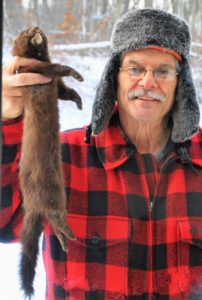Photography courtesy of Lowell Washburn, all rights reserved.
The American mink is a highly curious, yet amazingly wary, aquatic predator. An outsized member of the weasel family, the mink is so crafty, in fact, that many experienced trappers think catching one presents a challenge equal to outwitting the fox or coyote. I don’t know if mink are really that smart or not, although at least one animal behavioral study has proven them to be smarter than cats, whatever that means. What I know for certain is that during the course of more hands-on intelligence studies, mink have frequently proven to be smarter than me. Just sayin’.
Prized for their thick and durable winter pelts, mink are found statewide in Iowa. Like all members of the weasel clan, they are serious predators; subsisting on a diet of fish, rodents, crawdads, and birds. Muskrats are a preferred menu item and mink are a muskrat’s worst nightmare. When a hungry mink suddenly appears in the underwater entrance of a muskrat’s cozy winter lodge, there is little hope of escape.
Not all mink are fully aquatic. Adventuresome individuals may temporarily abandon their watery habitats to set up shop in the wooded uplands where they move into woodchuck burrows or hollow logs. While living in the uplands, mink prey on white-footed mice and cottontail rabbits and will readily climb trees in search of squirrels and chipmunks. Roving mink can also wreak havoc on domestic poultry. Once the raids begin, they are impossible to discourage. Unless the predator can be caught and removed, the entire flock may be lost.
Mink, like all weasels, are wonton killers. I once visited the loft of a Mason City man who kept a large number of trained homing pigeons. A mink had gotten into the pigeon coop and killed nearly all of his birds. The animal then used the bodies to construct a three-foot-high pyramid in a corner of the building. Adding insult to injury, the marauder had not consumed so much as a single bite from any of the homers. The killing spree had been conducted just for fun.
Listening to Old Timers’ tales as a child, I was fascinated with mink long before I ever laid eyes on one. And although I never developed into a great mink trapper, I’ve always had a lot of fun trying. I usually need all the help I can get, and mink always seem easier to figure out once things freeze up and a layer of fresh snow reveals the most heavily used streamside travel routes. On ponds and marshes, the search can often be narrowed by locating airholes where mink climb onto the ice while dining on catches of fish and crawdads.
Although certainly less common, mink living in woodland settings may prove most predictable – especially when their comings and goings center around a single den site. A classic example occurred earlier this month when I discovered where a mink had moved into an abandoned fox den. Sign was everywhere, and daily activities seemed well defined. Using a partially eaten rabbit leg as bait, I caught the prime 23-inch male on the first night.
Mink rarely come that easily for me. Most are difficult. Some are impossible. The most memorable of my worst-case mink trapping scenarios occurred during November of 1981. Ed Kotz and I were trapping muskrats at Mallard Marsh located near Fertile, Iowa. It was one of those rare instances when local muskrat populations, overseas market demand, and raw fur prices had all soared into the stratosphere. Running our trapline in lightweight duck boats, success had been the best ever. During our biggest single day, the marsh had yielded an incredible 135 muskrats.
And then it happened. Following an unprecedented run of trouble free trapping, it began to rain on our parade. Disaster had arrived in the form of a mink which had apparently discovered that a freshly trapped muskrat makes an easy meal. It wouldn’t have been any big deal if the mink had merely taken a ‘rat or two. But that wasn’t the case. This mink was taking a lot of muskrats; making but a single, pelt destroying bite before moving to the next fresh carcass. Once it had announced its arrival, the mink staged a devastating encore performance every single night.
Although we tried everything we could think of, the rogue ignored our traps and continued to destroy our take. Following days of frustration, the mink was finally captured one stormy night when it paused to investigate a muskrat carcass we had partially concealed in the side of an active muskrat lodge. It was a simple set that the predator had undoubtedly passed and snubbed many times before.
The dark, sable colored male was a sight to behold. Measuring a full 30-inches in length; he was the largest mink we had ever taken. He was indeed the trapline culprit. Once the mink was trapped, pelt damage immediately ceased. I don’t remember exactly how many pelts that rampaging mink destroyed, but it was a lot. The loss was made especially painful due to the fact that we had been selling many of our prime [unskinned] muskrats for more than eight dollars apiece which, according to U.S. Bureau of Labor statistics, would have the buying power of $21 in today’s economy.
Although the mink was in prime pelt condition, we never did sell its hide. Instead, I had the huge male mounted by a professional taxidermist. Today, the Rogue of Mallard Marsh surveys his domain from my office book shelf.




 Tom Cope
Tom Cope Sue Wilkinson
Sue Wilkinson Susan Judkins Josten
Susan Judkins Josten Rudi Roeslein
Rudi Roeslein Elyssa McFarland
Elyssa McFarland Mark Langgin
Mark Langgin Adam Janke
Adam Janke Joe Henry
Joe Henry Kristin Ashenbrenner
Kristin Ashenbrenner Joe Wilkinson
Joe Wilkinson Dr. Tammy Mildenstein
Dr. Tammy Mildenstein Sean McMahon
Sean McMahon